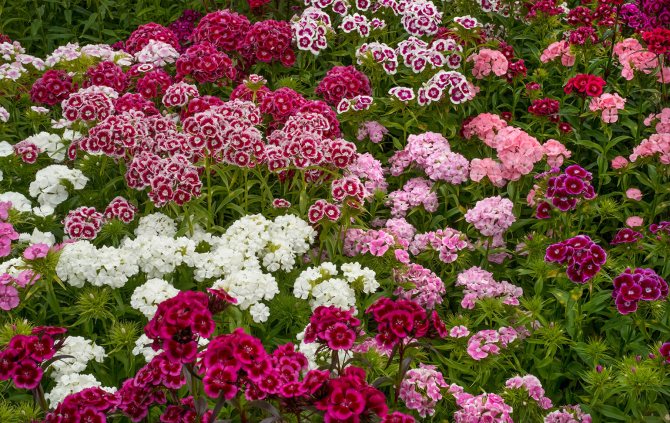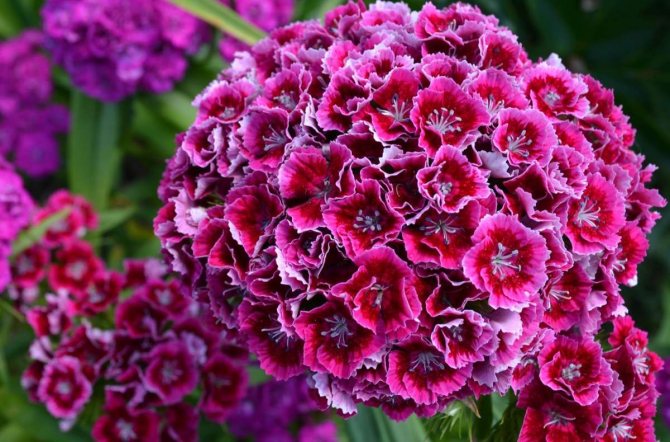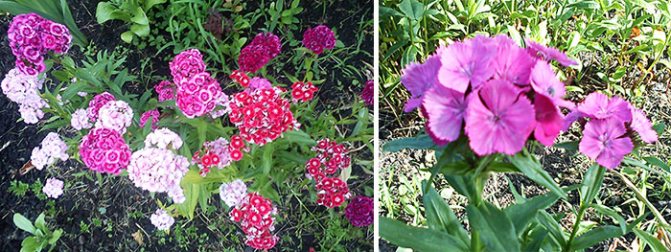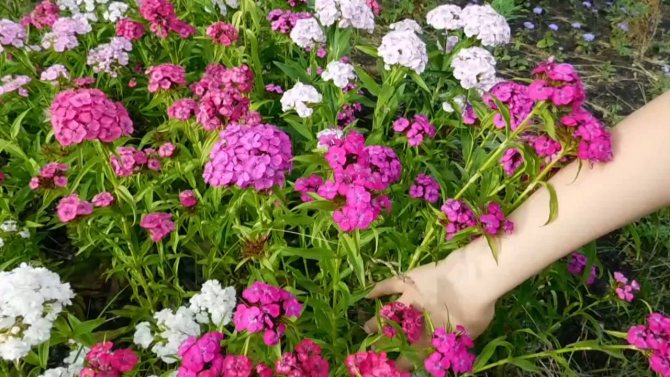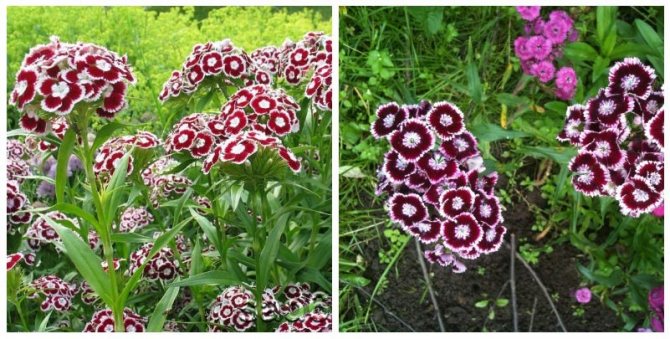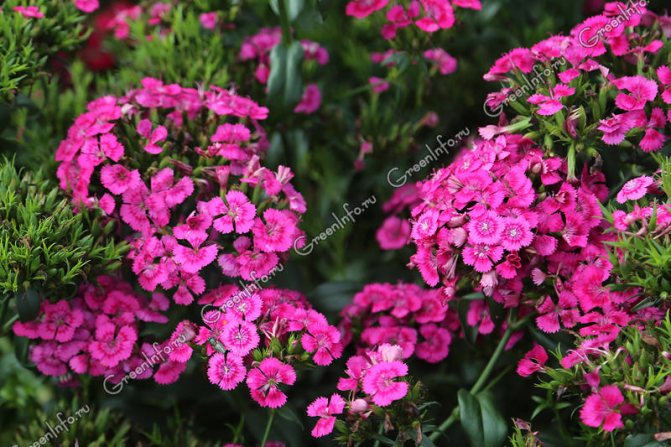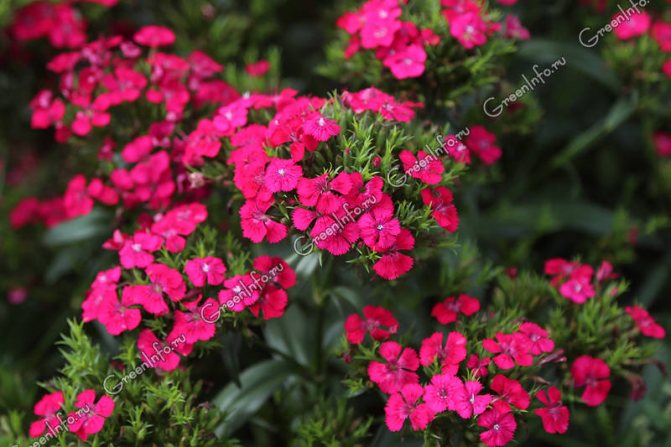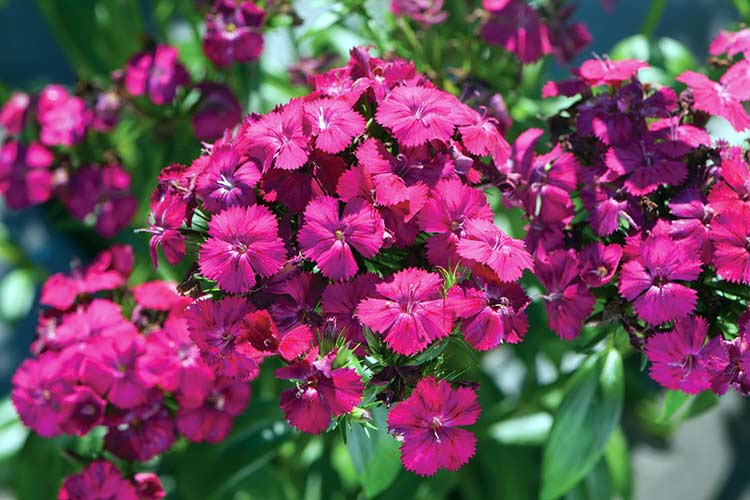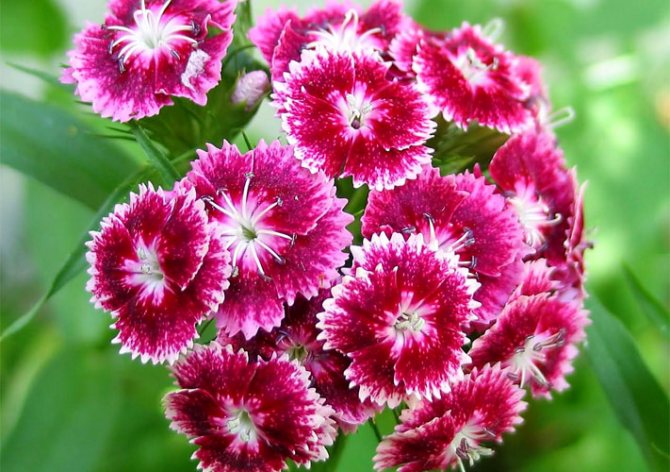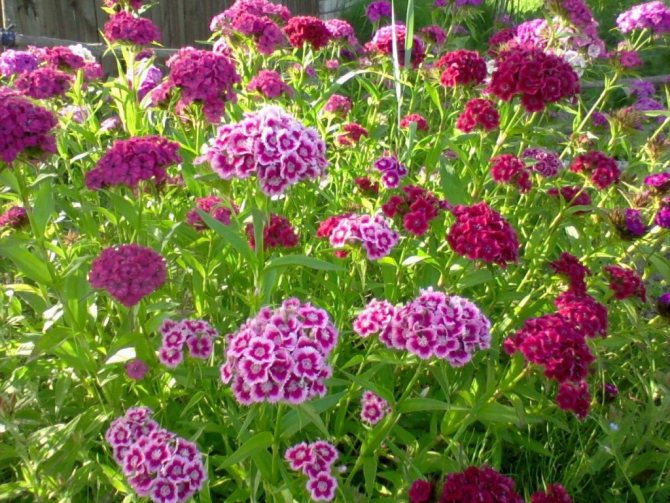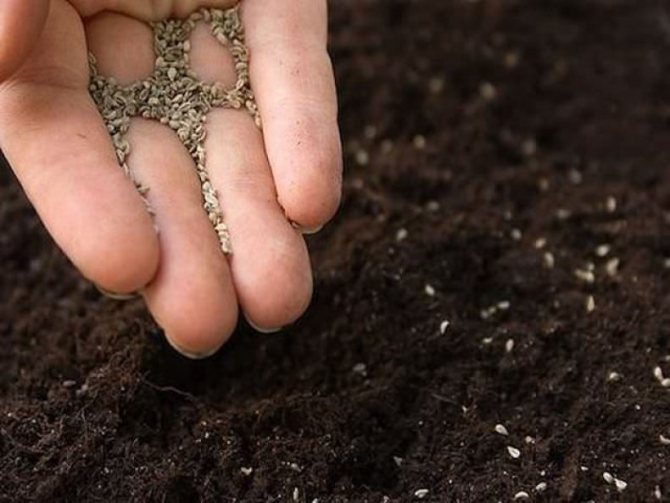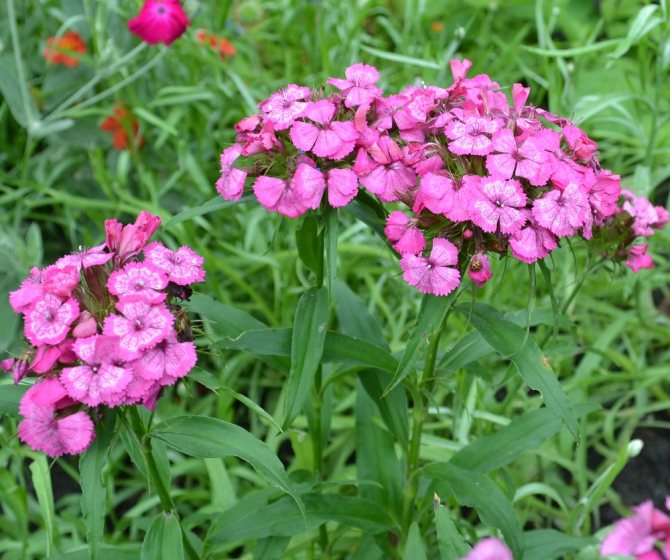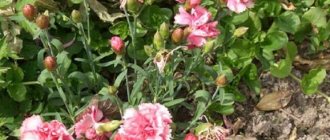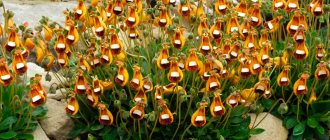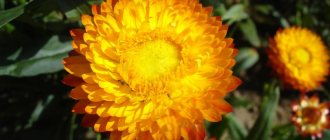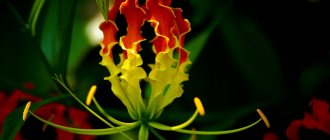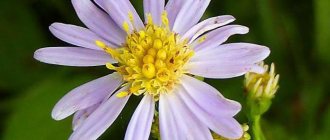Turkish or bearded carnation is a beautiful flower with a rich, pleasant aroma. The Greek word Dianthus, from which the genus of carnation got its name, means "divine flower". It has about 300 species of herbaceous annuals and perennials and, in addition, an endless variety of varieties and hybrids of valuable decorative flowers, common both for the bright beauty of fragrant inflorescences and for ease of cultivation.
Since ancient times, carnation has been associated with victory in bloody battles. In America, she is considered a symbol of maternal love. According to Christian legend, during the execution of Jesus Christ, where the tears of the Virgin Mary fell, these extraordinary flowers appeared.
Turkish carnation is still highly valued among gardeners for its lush, long-lasting, abundant flowering, a varied palette of colors, unpretentiousness, and a subtle enchanting smell.
Description of Turkish carnation
The Turkish carnation is one of the most common types of plant grown in flower beds. She fell in love with gardeners back in the 16th century for her bright flowering hats. This ornamental plant comes in different shades. There are both monochromatic white and different shades of red, and two- and even tricolor with different patterns on the petals of medium-sized (1-1.5 cm in diameter) flowers. The designs range from petal borders to eyes and intricate shapes. And the carnation petals themselves are very diverse. There are also five-petal varieties and varieties with double flowers. Carnations bloom from the beginning of summer for a month.
Botanical description
In general terms, all Cloves are similar to each other, they are distinguished only by the nuances of their appearance. But what are these nuances! Is it possible to compare the Turkish carnation - the noble lady Dianthus barbatus dressed in brocade and studded with jewels of all shades - and the modest country girl - the herbal carnation? It turns out that you can.
Carnation herbal
Both the first and the second grow in several upright, rigid woody stems, consisting of long segments connected by thickened nodes (in the manner of bamboo). The nodes serve as places of departure from the stem of narrow, sessile, oppositely located, undisturbed rigid leaves of a lanceolate-linear shape.
The color of the leaves can be dark green, and green-bluish, and have a reddish tint. There must be a powerful root rosette, which almost immediately turns into a fibrous root in a Turkish carnation and a short rhizome in a grass.
With the same structure, the shoots have a different function: there are only bearing leaves, there are flowering ones.
But if the grass has single flowers, then in her Turkish "sister" they are collected in a heavy and voluminous inflorescence-shield, similar to a honeycomb, where all flowers are at about the same stage of development (if the buds are all the buds, if wilting, then also amicable ). The number of always five-petal flowers and their color depend both on the variety and on the growing conditions.
"Zeus", or "divine flower" (often having a tinge of caked or fresh blood, and the king of the gods adored bloody scenes) has a second name.This carnation is also called bearded because of the ciliated edging of each flower of small, tightly adjacent leaves, which looks like a long thick bristle.
Planting a carnation
The most beautiful Turkish carnation grows in fertile soil. It blooms well in open sunny areas, but will grow in partial shade. If fertilizers are added to sandy loam and loamy soils, then they are quite suitable for Turkish cloves. Introduce compost or humus, ash, mineral fertilizers before planting when digging into the soil.
It is not necessary to dig up the future bed too deeply, 25–30 cm is enough. Further, the bed is leveled and moistened if the soil is dry. The prepared area is covered with a thick cloth for two weeks. When time has passed, you can start planting flowers.
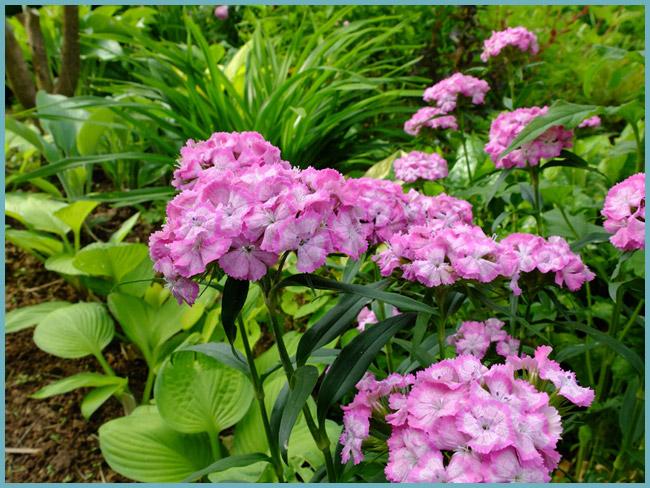
If the soil is fertile enough - the flowering of carnations will be long and lush.
Seeds are sown into furrows up to 1.5 cm deep. The intervals between furrows should be at least 15 cm. Seeds are sown into the furrows, watered and sprinkled with earth. The soil needs to be lightly tamped. You no longer need to water, you just need to cover the bed with a thick cloth before the first shoots.
Carnation can be planted both in spring and autumn. It is performed using the same technology.
Attention. During fall planting, both seeds and furrows must be dry.
Flower propagation
Experienced gardeners advise planting cloves as often as possible. Some species cannot boast of a long lifespan and decorate the garden for only 3-4 years. Perennial representatives also require constant updating. After 2-3 years, they begin to lose their decorative effect: the bush is spreading and "balding".
By cuttings
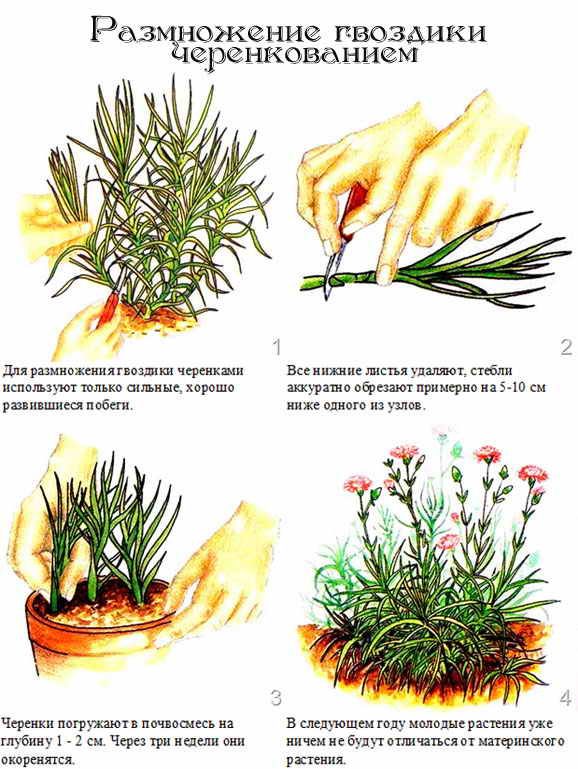

This is the most popular, simplest and most effective way. It is suitable for most species, with rare exceptions (annual species). The planting material initially develops in perlite or calcined sand. This choice is explained by the desire to protect the young plant from various fungal diseases.
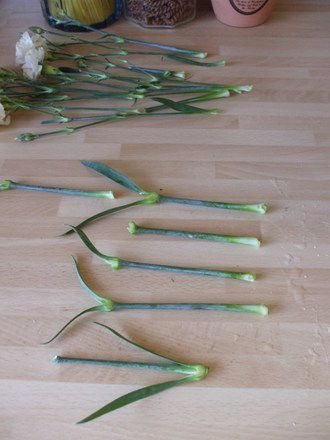

The best breeding season in this way is May, early June. At this time, you can easily distinguish between the vegetative shoot and the peduncle. Planting material should be 4-8 cm in length. Each variety has its own requirements, but 2 leaves should be in any case. Cuttings are cut at an acute angle. On an adult plant, the place must be immediately treated with wood ash. The lower leaves are removed.
Using a sharp knife, oblong cuts should be made in the lower part of the divider. With this part, the cuttings are placed in a container with a substrate. The container is covered with glass or foil. This creates a greenhouse effect and provides the necessary moisture. If reproduction occurs on a large scale, then the pots with cuttings are stored in a greenhouse without heating. Wherever possible, use a fogging machine. No soil heating is needed. The root system appears within 3-4 weeks.
Layers
If the species has long growing shoots, then they can be bred in this way. For this purpose, an incision is made with a sharp knife on the lower part of the stem, depth to full thickness. This part of the internode is bent to the soil, fixed with special brackets and sprinkled with a layer of earth. The soil is constantly moisturized. After the formation of a separate root system, green shoots appear from this tubercle of earth. This serves as a signal for the separation of the young plant from the mother.
By dividing the bush
This method is only used for some species that sod fast-rooting shoots. Mainly for bearded carnations. The procedure is carried out in March-April. This will give you the opportunity to enjoy flowering in the same season.
Seeds
Best used for biennial and annual species. By purchasing seeds in special stores, you can find out in advance what type and color the culture will have. Sowing takes place in a container with sandy soil. This is best done in March.For fast germination, it is important to provide a favorable temperature (15-19 degrees). Seedlings are fragile. Transplanted into separate pots when at least 3 pairs of leaves appear. They dive very carefully. In open ground, carnations are transferred to the next year, in the spring.
It is better not to sow seeds directly into open ground. Slow growth and particular fragility can cause stunted growth or even death of seedlings. Weak seedlings are unable to withstand weeds and other factors.
Turkish carnation care
As already noted, carnations feel best in sunny areas in fertile soils. These flowers are very sensitive to winter temperature fluctuations. This is especially true for young plants. Turkish carnations do not tolerate waterlogging and stagnant water.
Plants are most at risk in early spring, when temperature drops are especially great, because during the day the plants are heated in the sun and freeze at night. To prevent the plants from dying during this period, frost-resistant varieties should be covered with spruce branches. It is possible to remove the shelter only when the probability of recurrent frosts disappears.
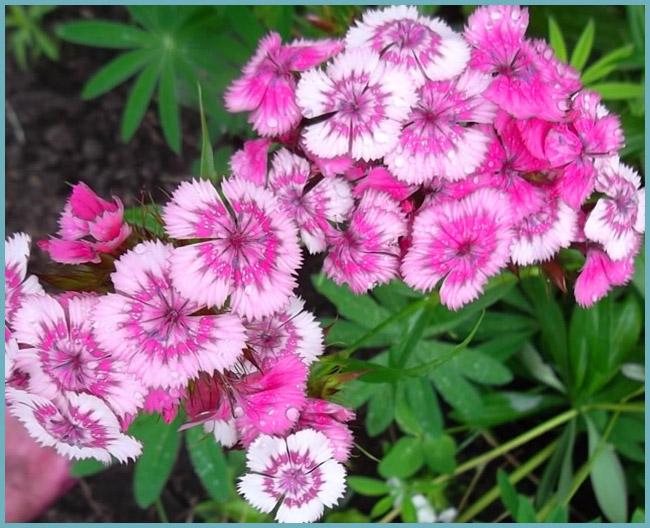

Protect Turkish Cloves from Frost
When the carnation has faded, the stems need to be cut and fertilized. Thus, in a month the plant will already grow new stems, and some varieties will bloom again. Turkish carnation, cultivated according to all the rules, lives up to six years, while poor conditions reduce its life in a flower garden to three years.
Water the cloves once or twice a week. And if the summer is dry, then the amount of watering needs to be increased. Water the plant on the ground, because if water drops on the flower, it can burn out in the sun.
Attention. Carnation does not tolerate waterlogging.
Turkish carnation from seeds at home Sowing seedlings
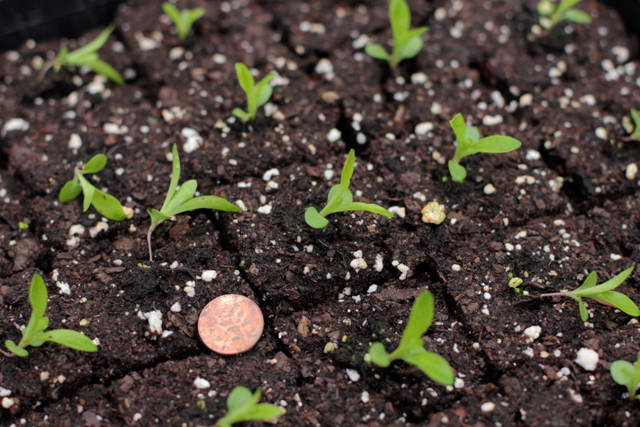

Turkish carnation growing from seeds when to plant photo
Bearded carnations are sown on seedlings with the onset of February into a special soil.
- The seeds are small, but it is quite possible to spend a little more time and plant the seeds in a separate glass. So you save yourself from the picking procedure.
- They do not deepen much, by 0.5-1 cm.
- Watering is needed moderate, a drainage hole in the container is required to prevent stagnation of water.
- Seedlings are placed on a sunny windowsill, where caring for it comes down to watering every two to three days.
- Shortly before planting, the seedlings are hardened by placing them on the street in a place without strong drafts - first for an hour or two, gradually increasing the time to a full day.
- It is possible to plant seedlings from the end of April, but only when the threat of night frosts has passed.
How the picking of a Turkish carnation is made, the video will tell:
If you sowed seeds in a common container rather thickly, you should make a pick. Plants are transplanted into separate containers, while trying to damage the roots as little as possible.
Fertilization and feeding
Turkish carnation, planting and caring for which were described above, also needs feeding. When growing carnations in open ground, the first feeding of the plant is done when it has reached a height of 10 cm. 1 tbsp is used as fertilizer. l. nitrophoska and 1 tbsp. l. Agricola Forward diluted in 10 liters of warm water.
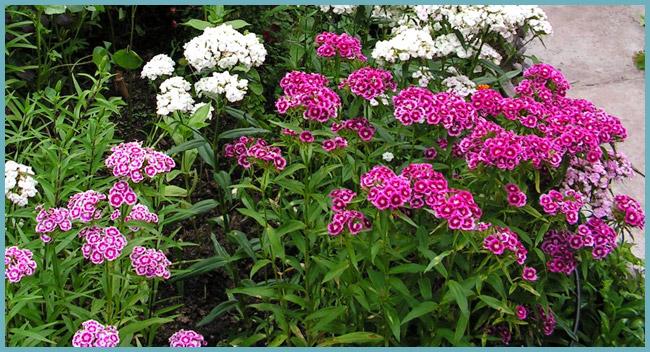

Feed the crop several times per season
When your flowers begin to acquire buds, you need to carry out a second feeding. This time you need to use 1 tbsp. l. potassium sulfate and the same amount of superphosphate, also diluted in 10 liters of water.
The third dressing is applied directly during the flowering period of carnations for 10 liters of water, 1 tbsp is needed. l. fertilizers "Agricola for flowering plants".
Attention. Top dressing consumption should be 10 liters per 5 sq. m.
Variety of species and varieties of bearded carnations
One variety, Haymatland, was cultivated for a long time. A plant with large burgundy inflorescences up to 45 cm high. Later, terry and dwarf varieties were bred by breeders.
Now the varietal variety has exceeded three hundred.
- Dwarf varieties
: Midget (white), Lilipot (terry color mixture). - Terry varieties
: Surprise, Diana, Snezhana, Terry carpet, Terry mixture, Breath of love, Grace. - Popular among Russian gardeners
: Coal (bright, with a dark color: crimson, purple, burgundy shades), Chardash (dense inflorescences in the form of a ball), Mazurka (non-double variety). - With an unusual color
: Black and white (the center of the inflorescence is black, and the ends are white), Jolt Pink (bright pink or fuchsia), Noverna Clown (buds of different colors on one inflorescence).
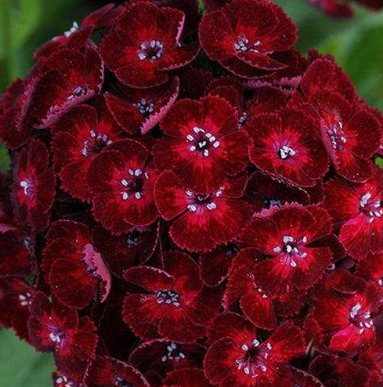

The bearded carnation goes well with annual low flowers: asters, phloxes, calendula. To form a cascading flower bed, you should pay attention to the height of the plant: place the high ones in the background, and put the low ones in front. It is possible not to distribute according to the color scheme, all colors are combined with each other, complementing each other.
"Turkish carnation"
"Terry Turkish carnation" www.all-flowers.
| "Turkish carnation" | Location:The soil:Reproduction:Winter hardiness:"Yellow Carnation Grenadine" CHINESE CARNATION: | "Chinese carnation" |
| "Pinnate carnation" | "Terry feathery carnation" Meggie " | "Terry feathery carnation" |
HERBAL CLOVES:
The most common of the Perennial Carnations in our gardens is Carnation - Herbs. Forms a pillow of slightly lodging thin shoots. The flowers of modern hybrids are quite large, all shades of pink, with different patterns. The main advantages are good germination, unpretentiousness, frost resistance, bright flowers. Among the shortcomings - lodging of peduncles, fragility.
| "Clove herb" | "Clove herb" |
HYBRID CLOVES
Team group. Most varieties and hybrids are produced by breeders from the Dutch Carnation. They are very diverse and for convenience they were combined into 5 garden groups: 1. Shabo carnation (see above), 2. Grenadine carnation (see above), 3. American carnation group, 4. Dwarf carnation group and 5. Carnation group "Souvenir de Malmaison ". There are more than a thousand varieties of Carnations and new ones appear every year. Compared to the old varieties, the new varieties have repeated flowering, have stronger peduncles and different stem heights, which determines their place in the flower garden and the purpose of the flower in the design. Carefully studying the labels of flowers, you must immediately determine the location in the garden.
| "Feathery Carnation" Rainbow of Love " | "Garden carnation Grenadine" | "Carnation-herbal" |
| "Pinnate carnation" | "Chinese carnation" | "Carnation-herbal" |
Growing Carnation Perennial - planting and care:
Location:
Best of all - sunny, in partial shade stretches.
"Carnation-herbal"
Growing Shabo Carnations, in my opinion, is the most laborious: seedling, picking, pinching, hardening, garter. But whoever does not stop it - the result exceeds all expectations. The flowers are huge, of a wide variety of colors. I grew soft lemon pinks. Peduncles require a mandatory garter. The cultivation of Turkish and Chinese carnations, as well as herbal carnations is not very difficult. Although terry varieties can fall out in winter without shelter
CLOTT OR DIANTHUS
"Chinese annual carnation"
CARNATION OR DIANTHUS is a very large genus of flowering plants. It includes both Perennial and Biennial and Annual Carnations. Many perennial species are grown here as Letniki or biennial plants, although in favorable winters with high snow cover they can grow in one place for several years. They are all herbaceous plants.
The Clove has a smooth, knobby stem. Linear narrow leaves, bluish-green, or even bluish.Species Carnations have simple, non-double flowers, predominantly pink and have 5 petals.
In culture, Garden carnations are most often grown. The color of Garden Carnations is amazing!
There are both bright, saturated tones, and fawn of all shades of pink, yellow, purple, white and combined: strengthening the pattern to the center of the flower, or, conversely, with a contrasting border around the edges, with dots and strokes on the petals.
The most popular types of Cloves:
TURKISH OR BEARDED CLOVES:
"Turkish carnation"
"Terry Turkish carnation" www.all-flowers.
In places of natural growth in the south of Europe, the Caucasus, a perennial herb. In our climate, it is often grown as a biennial. In warm snowy winters and with good mulching, it can overwinter and grow for several years in one place. Bearded named for pubescent bracts. Stems are straight, rather strong, up to half a meter high. The leaves are narrow, lanceolate. Flowers of various shades of red and purple, as well as white with very beautiful patterns in the form of borders, spots, strokes, are collected in a rather large hemispherical or corymbose inflorescence. Flowering in the middle of summer in the second year from sowing, long. With timely removal of faded inflorescences, it can be repeated. Gives self-seeding.
Has a huge number of varieties. Modern series can flower in the first year after sowing.
| "Turkish carnation" | "Turkish terry cloves"Growing Carnations Shabo - planting and care:Location:Solar. In the shade or partial shade, it is strongly stretched and blooms poorly. The soil:Soil requirements are neutral, well-drained, rich in nutrients. Reproduction:Seeds through seedlings, in the most beloved bushes, leave the entire mother plant for growing in the winter garden (or storage in the cellar in a wet state) and root the lateral shoots in the spring by cuttings. Seeds of terry varieties often do not give terry in subsequent generations, being hybrids. Winter hardiness:Low. In the Urals, Carnation Shabo does not winter in the open field. DUTCH OR GARDEN CLOVES, GRENADINE FORM:"Yellow Carnation Grenadine" A modern hybrid up to half a meter in height with a thin but rather strong stem and several flowers of various colors. Grown through seedlings, flowering in the second year, long-term. In the first year, a rosette of leaves is formed, which must be highly mulched with compost or humus. The flowers can be plain or double in all shades of pink, cherry, yellow or white, with different patterns on the petals. Fragrant flowers with a delicate aroma. In good conditions, for example, in greenhouses, the number of flowers on one bush can be several dozen at the same time. CHINESE CARNATION:A perennial herb native to the south of the Far East, China and Japan. We grow it as an annual. It has many garden forms and hybrids with simple and double flowers. Species plants have lodging shoots up to half a meter long. Hybrids have more compact cushion forms with larger flowers. Flowers are most often solitary pink and lilac shades. Unprotected. Beautiful specimens can be brought into the cellar for the winter, kept damp until spring. Cuttings in the spring. | "Chinese carnation" |
Plant propagation
Reproduction of the Turkish carnation is most often carried out by seeds or layering. In order to propagate a carnation by layering, you need to follow a simple algorithm of actions:
- in July or August, the shoots must be tilted to the ground, secured and sprinkled with soil;
- tie the stem to the peg, keeping it upright;
- take care of shoots that will appear in a few weeks;
- in the fall, new shoots must be cut off and planted in open ground.
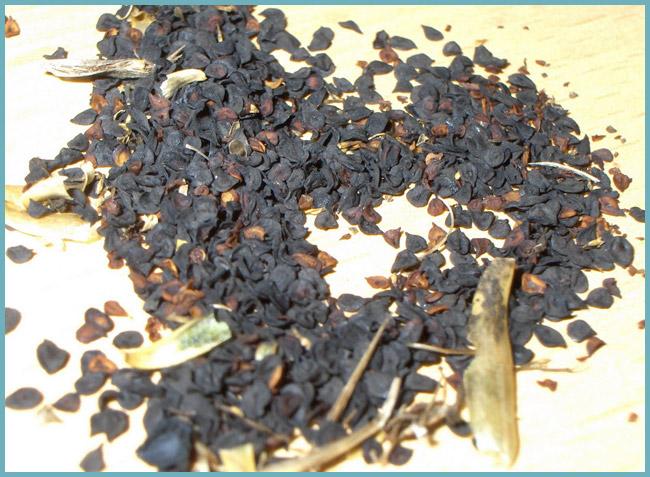

Turkish carnation seeds
Another way to propagate Turkish carnations is cuttings. For this, I most often use shoots that have not formed inflorescences in the current year.
You can also use bushes that have grown in open ground as a result of self-seeding of carnations as seedlings. They just need to be transplanted to the place you need. However, it is worth remembering that self-seeding often loses the distinctive features of varieties.
Propagation by cuttings
They are cut from a stem taken from a plant of the second year of life, planted in loose moist soil, creating a light shade. After about 3 weeks, the seedlings will begin to grow - this can be determined by the appearance of new leaves. They are transplanted in August. They will bloom next year. If you carry out this operation in a greenhouse or greenhouse, then the cuttings will take root much faster. This method is used if you want to keep the variety you like.
Turkish carnation is capable of self-seeding propagation. Of course, there will be much fewer plants, but they will still delight you with magnificent flowering.
Diseases and pests of Turkish carnation
The Turkish carnation plant is resistant to diseases, but occasionally, mainly in the southern regions, it can contract a viral disease that is spread by sucking insects. It manifests itself in the inhibition of flower growth, the appearance of a mosaic color on the leaves, followed by their deformation. In this case, the diseased plant must be destroyed immediately, preventing infection of other bushes.
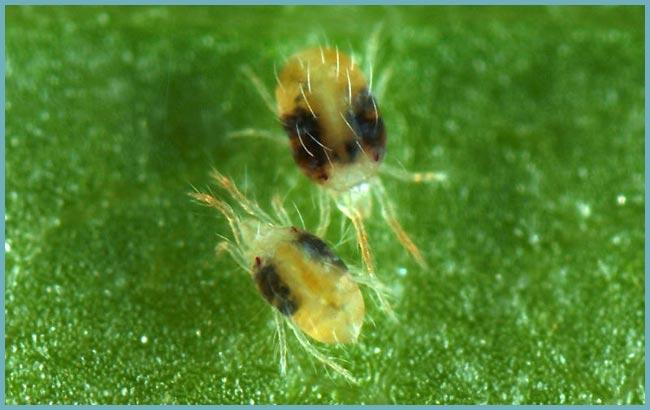

Spider mite
It can also occasionally be found in the Turkish carnation. heterosporiasis... This fungal disease manifests itself on the leaves and stems in the form of medium-sized gray spots. Sometimes the spots have a red border. Subsequently, the spots brighten and merge with each other. In this case, the flower becomes fragile in the place of accumulation of spots, the leaves turn yellow and die off. The fungus lives on the plant even after it has died, therefore, in case of infection, all remnants of the diseased flower must be carefully removed, and the surrounding plants must be treated with Bordeaux liquid or copper oxychloride.
Of the pests, Turkish carnation planted in open ground can attack spider mites and aphids.
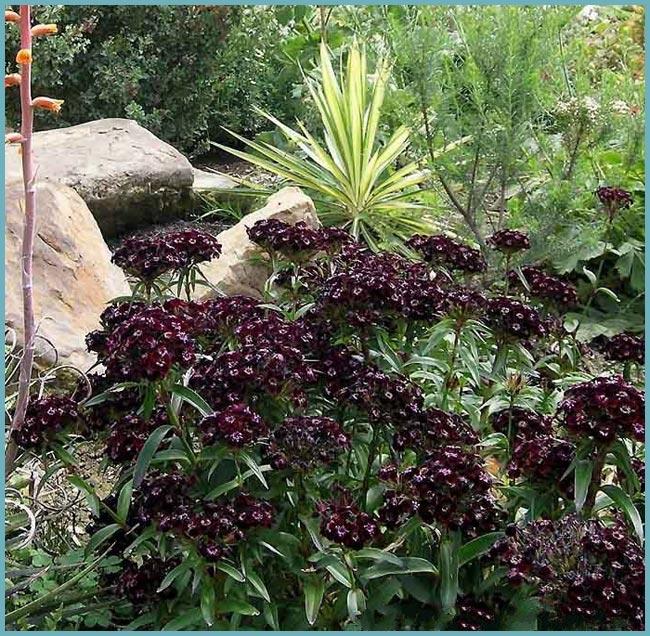

Turkish carnation in a flower bed
The simplest and most reliable means of countering these pests is considered to be a tincture of potato tops. To do this, 10 liters of water requires 1 kg of potato tops, infused for one and a half days. Before spraying, add 1 tbsp to the tincture. l. liquid soap.
Advice. Spray cloves in a cool morning or evening.
Sowing in protected ground, in a greenhouse
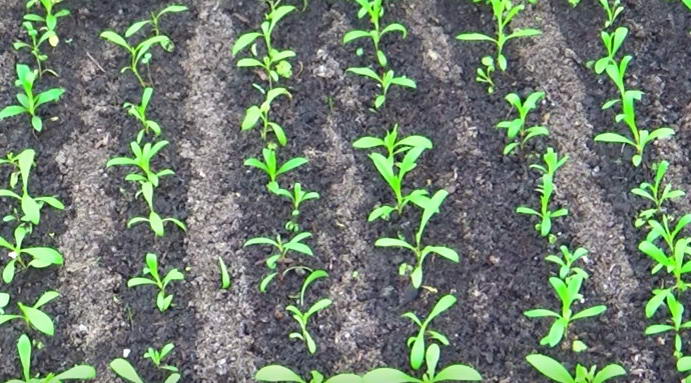

Seedlings of a Turkish carnation photo Planting a Turkish carnation for seedlings
- Choose a well-lit place for seed germination, maintaining the temperature there at least 13 degrees.
- Cover the garden with glass or foil to speed up growth.
- The sprouts appear together, about 2-3 weeks after sowing.
- When the seedlings grow up, do not forget to thin them out or plant them in another bed.
- Before transferring the seedlings to the garden, feed them with nitrogen fertilizer - it is used as an anti-stress drug.
- Carnations can be planted in a flower bed at a distance of 25 cm from each other when the weather is warm.
If you grow seedlings and thus extend the growing season, you do not need to cut the flowers and enjoy the flowering this year.
Turkish carnation in landscape design
In landscape design, Turkish carnation is used quite often. A big role in this is played by the ease of care of this flower, combined with its incredible beauty. Use cloves to create spectacular borders. Can carnations in landscape design and play the role of a lawn and serve as ground cover plants. Bright caps between the tiles of the sidewalks, framed by the steps, and decorate the retaining walls will look great.
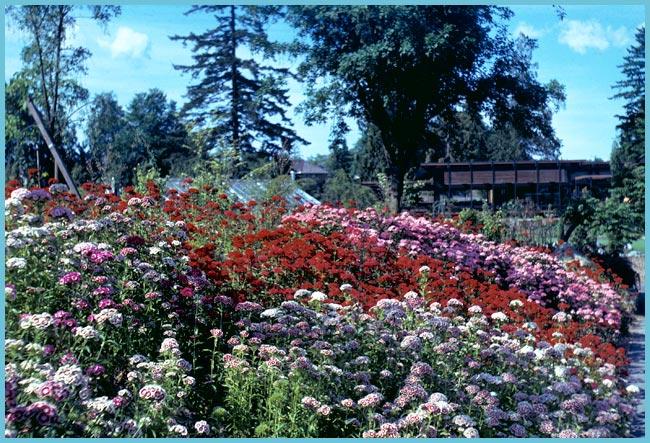

Turkish carnation in landscape design
This flower is often used to decorate alpine slides.In addition to colorful flower beds, you can diversify your landscape design with original monochromatic duets, for example, in a combination of red carnations with blood-red geraniums.
In addition, this flower can be planted in pots and decorate terraces and rooms with small flower beds.
This flower also looks great when cut in bouquets, both as a solo plant and in combination with other flowers.
It all depends only on your imagination. And if you do not have enough inspiration - look at the photos with these beautiful flowers, perhaps they will help determine the best place for carnations in the flower garden.
The Turkish carnation is one of the most unpretentious garden flowers to care for, which pleases anyone, even the most capricious grower, with its bright saturated beauty.
Description of the flower
Dianthus barbatus is a species of the clove family and enjoys a temperate climate. Unlike the Chinese carnation (Dianthus chinensis), the Turkish carnation is a frequent inhabitant of flower beds, front gardens of garden plots.
She, like her Chinese relative, forms only bushes with rosettes of leaves in the first year of life. From the second, it begins to simultaneously throw out peduncles and additional rosettes of leaves. This allows her to bloom in all her glory for up to 4 years. However, flower growers, summer residents, residents of private houses often grow these cultivated garden varieties as biennials.
Small flowers form umbrellas with lush, fragrant bright inflorescences up to 15 cm in diameter. They are located on each stem. The flowers have 4 bracts each with a beard-like shaggy border around the edges. It was they who gave her the name "bearded".
Loading ...
Turkish carnation has a huge variety of colors of simple and double flowers. They can be red, crimson, burgundy, pink, white or variegated with different shades, patterns in the form of borders, specks, strokes. Inflorescences with a very delicate aroma resemble large caps on stems with leaves, which can also be colored in different tones. Probably, this bright color scheme of petals is also associated with the ornament on Turkish carpets ...
Turkish carnation: photo
Seedling growing
When growing Turkish carnations from seeds, sowing is carried out in March or in the first decade of April. In order to get strong healthy seedlings, the seed must be placed in a previously disinfected substrate. Disinfection is usually carried out with a dark pink solution of potassium permanganate. The substrate itself must be fertile, it is often made up of leaf humus and sand.
So, the cultivation of Turkish carnations in a seedling way.
- We rinse the container for seedlings with hot water, lay a drainage layer on the bottom, and a moistened substrate on top.
- We sow seeds, laying them to a depth of about 1 cm.The distance between them should be 2-3 cm.
- Cover the container with loose paper and keep it at a temperature of + 16..18 ° C. Moisten the substrate periodically.
- When shoots appear, we transfer the container to a well-lit place and lower the temperature by a couple of degrees.
Note! If the air temperature is high, the seedlings can stretch out a lot!
- As soon as a pair of real leaves appear on the seedlings, we dive them into separate peat cups. We use the same soil mixture.
A couple of weeks before transplanting a carnation into the open ground, you need to start the hardening procedure. Every day we take out young plants to fresh air, daily increasing the exposure time. After two weeks, the seedlings should fully get used to the new environment. It is desirable that by this time they spend the night with the window open.
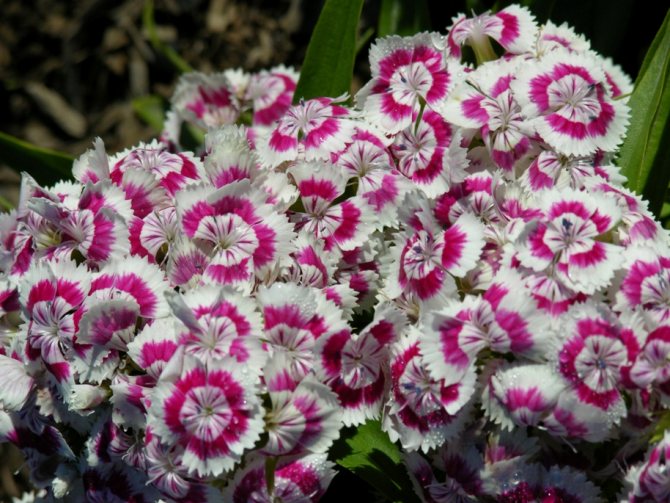

Reproduction
Turkish carnation cultivation from seeds, if you follow the rules is not difficult at all. In addition to reproduction by the seed method, there are other methods:
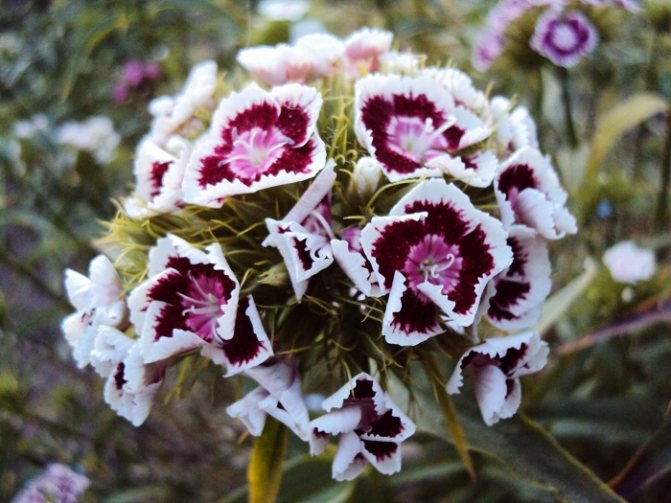

- Reproduction by layering.To do this, the flower stalk you like is pressed to the ground, attaching it with a wire (after cutting off the inflorescence). Sprinkle the branch with moist soil. After two weeks, the cuttings will take root, and after a month the first leaves appear, the flower is dug up and transplanted to a new site. Usually, reproduction begins by layering at the end of July and at the beginning of August.
- Garden carnation reproduces well by cuttings. Cut off the stems of a two-year-old plant, planting it in moist soil. After about 21 days, the young seedling will acquire the first green leaves. In the last week of August, it is transplanted, fragrant inflorescences will delight you with a riot of colors next summer. Growing this way, but in a greenhouse, will speed up the rooting process.
Important! Carnation can multiply by self-sowing, while varietal characteristics are lost.
Growing features
In order for the Turkish carnation to attract the eyes and delight for a long time with a beautiful flowering, you can plant only it in a flower bed or supplement it with other perennial plants. Suitable "neighbors" are:
- rudbeckia;
- Carpathian bell;
- alpine aster.
On a note. It is not forbidden to plant bushes along the fence, garden paths, decorate playgrounds, borders of green lawns, park compositions and mixborders with them.
Also, complete flower care includes protection from pests and diseases. Insects and rodents such as mice, mountain elephant, spider mite, caterpillars and aphids can affect delicate leaves and petals. Pest control should be done using treatments with various chemicals and folk remedies.
Of the diseases, the plant can infect:
- root gall nematode, causing deformation of leaves, their tarnishing;
- fusarium, provoking wilting of stems, dying off of aerial herbaceous parts of the plant;
- Rust causing bloated yellow spots on the leaves.
When affected by a nematode, diseased plants are destroyed by digging up from the root. Rust and fusarium are fought with preparations and homemade tinctures of onion peel.
Growing from seeds
Gardeners who prefer the seedling method of growing carnations begin work on the preparation of young stock already in the first spring month. The container is thoroughly washed with boiling water and baking soda; you can use long pots used to decorate balconies or ordinary boxes. Drainage is laid on the bottom of the container, on top of a soil composition consisting of sand and leaf humus in a 1: 1 ratio.
The land for sowing is moistened abundantly, but not excessively, you can water the site in advance for a day. The next day, the moisture concentration will reach the required level. Planting depth is not more than 1 cm, the intervals between seeds are up to 3.
The box is covered with ordinary paper (writing or newspaper), the soil is periodically moistened with a spray gun and the average temperature is kept in the room + 16… 18 ºC. This regime is maintained until the emergence of shoots.
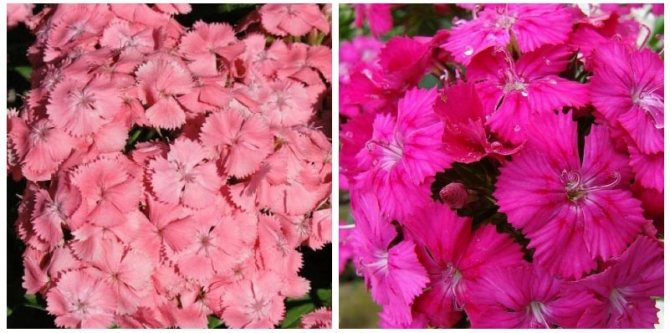

Newport Salmon Pink
Landing in open ground
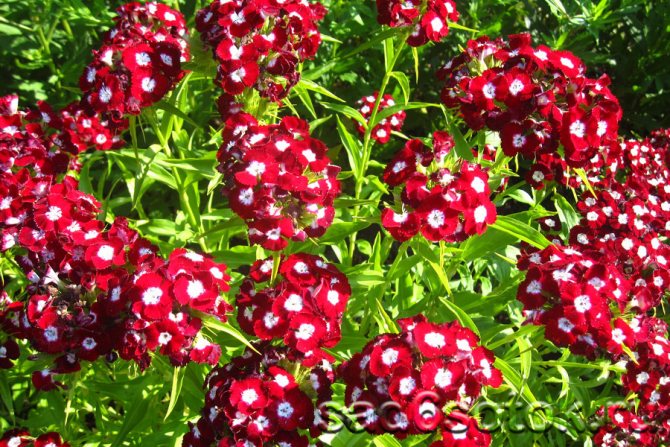

Turkish carnation variety Heimatland (Heimatland)
Turkish carnation is most often propagated by seeds through seedlings, valuable varieties and hybrids are successfully cut or planting material is obtained by dividing the bush.
Seed reproduction
Seeds are sown indoors in April or on ridges in May - June. The soil for sowing should be well warmed up and moderately moist. Considering the two-year growing cycle, a free plot of the garden or cold greenhouses and greenhouses that are empty after growing seedlings of vegetable plants are used for sowing seeds.
To grow seedlings, a mixture of humus, sand, garden soil and high peat is prepared by mixing the components in equal parts. Ready-made commercial neutral mixtures for seedlings of vegetables and flowers are also quite suitable.
When sowing in April, some varieties, for example, Holborn Glory or Gypsy, may bloom as early as August of the first year, but in this case the bushes will be weakened and will not show the desired decorative effect for the next year. For early summer abundant flowering, it is better to grow dianthus in a biennial culture.
Seeds are planted to a depth of 1–1.2 cm and mulched with humus crumbs or dry sand. If the weather is dry, the crops are watered by sprinkling. Strong shoots appear on the 8-10th day, and sometimes even earlier - after 5-7 days, depending on the quality of the seeds and the temperature of the soil. In autumn, branched bushes are transplanted to a permanent place.
The Turkish carnation works well by sowing directly into the ground without subsequent replanting. In this case, the sowing is carried out as indicated above, and then the seedlings are broken through at a distance of 20–25 cm. It is worth considering that in this case, during the first year, the flower bed will look quite modest.
When grown for seed, terry varieties can give heterogeneous seedlings - with non-double flowers or non-standard sizes, with elongated peduncles and stems, or, on the contrary, squat bushes.
To avoid confusion and get plants with typical characteristics of the variety, they use vegetative propagation methods - cuttings and division of bushes.
Cuttings
Cutting the Turkish carnation is not the most common method of propagation, but it is quite simple and allows you to accurately recreate the mother plant. Most often, they resort to cuttings of terry varieties and hybrids, two-colored or with fringed petals.
Cut green cuttings of vegetative shoots in June, in cool weather. The length of the cutting is 5–7 cm, the cut is made obliquely, directly under the internode, and the lower leaves are removed. For better rooting, they are treated with Kornevin: the ends of the cuttings are moistened with water and powdered with dry powder immediately before planting.
For cuttings, greenhouses, greenhouses are used, or planting is carried out directly into the ground, stretching a film over the plantings and maintaining high air humidity by frequent spraying. The cuttings are planted in light soil, dipping 2-3 cm, and mulched with sand or peat crumb.
Rooting lasts 18–20 days, after which the film is removed and the plantings are cared for in the usual way. In September, young plants are transplanted to a permanent place.
Dividing the bush
By dividing the bush, Turkish carnations are rarely propagated. To do this, in the fall, in September - October, the faded bushes are cut to a height of 10-15 cm and divided into sections with two or three shoots and a developed root system.
The resulting cuttings are planted in a permanent place, watered and covered for the winter. The decorativeness of such bushes can be significantly inferior to plants grown by seedlings or cuttings.
Care features
Caring for a Turkish carnation is not difficult. She feels great in our climate, easily tolerates the summer heat, is unpretentious and grows on any land. To get lush bushes and abundant flowering, a gardener needs to follow simple rules of agricultural technology.
Watering and feeding
Turkish carnations require moderate watering: they tolerate light overdrying of the earth better than stagnant moisture. Therefore, if the site with Turkish beauties is located in a lowland, it is important to drain the soil and equip drainage ditches. Immediately after planting, the seedlings are watered every other day until they take root - 2-3 weeks. In the future, enough 1-2 times a week, if there is no natural precipitation. Make sure that as few drops of water as possible fall on the leaves; water in the morning or evening.
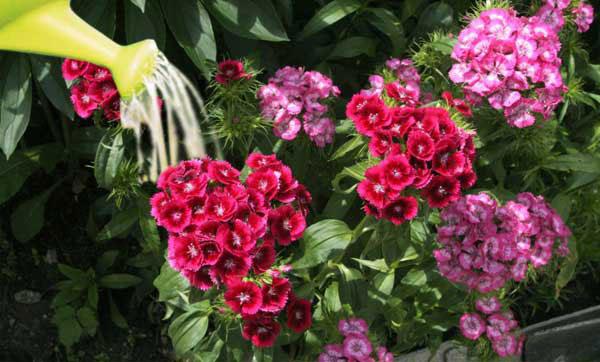

After the earth dries slightly, it is loosened. This procedure helps to retain moisture in depth and provide the roots with the necessary amount of oxygen. In parallel, weeds are removed around the bushes. Usually only young Turkish carnations need this procedure; adults themselves "strangle" unwanted neighbors.
Turkish carnations are undemanding to nutrients, but for abundant flowering it is better to feed them sometimes. Usually, double superphosphate or complex mineral fertilizers are used for flowering plants. Fertilizers are applied twice: at the time of laying the buds and after flowering. Youngsters for a more active set of green mass can be fed one-time with any nitrogen-containing fertilizer. This is done no earlier than two weeks after planting in open ground. All mixtures are diluted in water according to the instructions on the package.
After flowering
After flowering, the bushes are cut, leaving 5-7 centimeters, all flowers are removed. At this time, they can be transplanted to another place if necessary. Turkish carnations fertilize, water, loosen and remove weeds. After a few weeks, the dormant buds on the trunk wake up and produce new shoots that can bloom again in the fall.
If you want to collect seeds, the Turkish carnation, after it has faded, is not pruned, allowing the seed to ripen. Naturally, such bushes of buds are not tied again. The aboveground part is cut off in the fall, in preparation for winter.
Preparing for winter
Turkish carnation is a frost-resistant plant. Nevertheless, it must be cut off for the winter, leaving no more than 7 cm. Before the onset of frost, it is covered with peat, straw or sawdust, covered with branches on top. If a large amount of snow falls in winter, it is better to remove it from the flower bed, leaving a 10-15 centimeter layer. So in the spring, Turkish carnations will not suffer from excess melt water. The mulch is removed after the threat of severe frosts has passed - in early to mid-May.
General information
Turkish carnation is a garden perennial from the Clove family. In natural conditions, it is found in Southern Europe and Western Asia. For decorative purposes, it is grown everywhere. It is a shrub with linear-lanceolate opposite leaves, pointed at the ends. They can be green or reddish, depending on the variety.
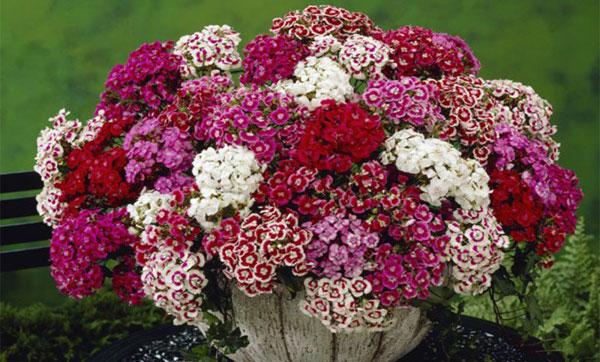

Buds are knitted singly or 2-3 pieces at the ends of erect, low, up to 60 cm, rather dense shoots. The calyx is cylindrical, the corolla is five-lobed, up to 12 cm in diameter; the petals are fringed-dissected, with long marigolds. The flowers often have a delicate scent. They can be terry or plain. The color of a Turkish carnation depends on the variety; there are pink, white, cream, red, burgundy. A lot of bicolor hybrids have been bred with an "eye" or contrasting framing.
Rules for care and cultivation in the garden
Caring for seedlings in the garden does not require any special trouble from the grower, it consists in maintaining soil moisture, weeding the grass, loosening and protecting against diseases. The carnation is also responsive for feeding, you should also not forget about them if you want to get a lot of bright hats on long stems. If you start planting, then questions will arise as to why there are no flowers or why the plant has withered. It's all about the attention and easy care about once a week, sometimes less.
- Watering. It is not worth watering the garden carnation bushes abundantly, the flower does not like strong waterlogging. It is enough to moisten the soil a couple of times a week in the heat, not allowing cold water to flow from the hose to the blossoming buds. Watering is desirable from a watering can without a spray, a stream under the roots. Waterlogging of the flower bed is fraught with the development of root and root rot, which can lead to the death of the flower.
- Top dressing. It is recommended to feed seedlings and bushes of the second year of life. It is allowed to add both purchased mineral preparations and organic matter. You can start feeding when the herbaceous bushes reach a height of about 10 cm. The second feeding is carried out at the budding stage. In the fall, it is also recommended to feed the plantings with manure, peat, humus, and mineral nutrient solution.
- Loosening, mulching. Regular weeding is important for growing the plant, as weeds can drown out seedlings and make them weak. Immediately after weeding the bushes, the ground around them is loosened, providing oxygen to the roots. Loose soil also absorbs moisture well, providing nutrition to the rhizomes. Mulching for protection from weeds and drying out of the soil is carried out with peat, sawdust or freshly cut chopped grass. In autumn, the soil is mulched with hay and straw to protect it from frost.
- Pruning. Only faded inflorescences are cut off from the flower so that the plantings do not lose their decorative appearance and look well-groomed. Also, this procedure stimulates re-blooming in late summer or early autumn.
- Transfer. In one place, the bushes can grow from 4 to 5 years, then degenerate, die. For lush flowering, it is recommended to transplant seedlings to a new place every 3-4 years in spring, looking for a sunny area without drafts and shade.
Growing methods of carnation
Before planting a Turkish carnation with seeds, it is important to figure out how, in what time frame and by what method you can grow flowers.
Cloves are grown from seeds either by seedlings or by direct sowing directly into open ground. If almost all growers are familiar with the seedling method, then the seedless one has several nuances.
You can sow Turkish carnations in the spring, as soon as the weather is warm and the threat of frost has passed. In this case, seedlings appear quickly, the flowers are less sick and are more resistant to diseases and temperature drops. Considering that the process of picking and replanting to a flower bed is excluded, the seedlings do not experience stress and grow faster.
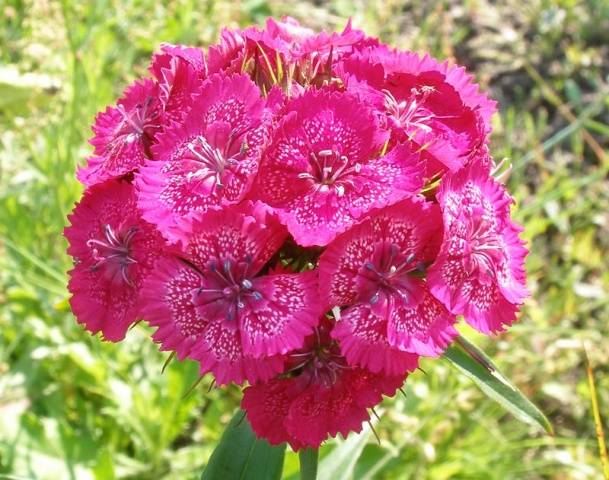

However, you can sow Turkish carnations with seeds in the fall when the first frosts hit. It is important to remember that flowers germinate very quickly, which means you need to completely exclude the possibility of their germination before the onset of winter.
Important! Not all varieties of cloves can be sown before winter - pay attention to the recommendations for sowing on the package.
What soils and places are preferred
Turkish carnation is an unpretentious plant that does not require strict conditions for growth and abundant flowering. These flowers look perfect in a flower bed, in a garden, in a flower garden in combination with other garden flowers, on a balcony, in containers and flowerpots.
The only thing this plant is critical to is illumination. The flower does not like too bright, sunny places. Therefore, it is advisable to plant Turkish carnations with seeds in partial shade or in areas illuminated in the morning and in the shade after lunch.
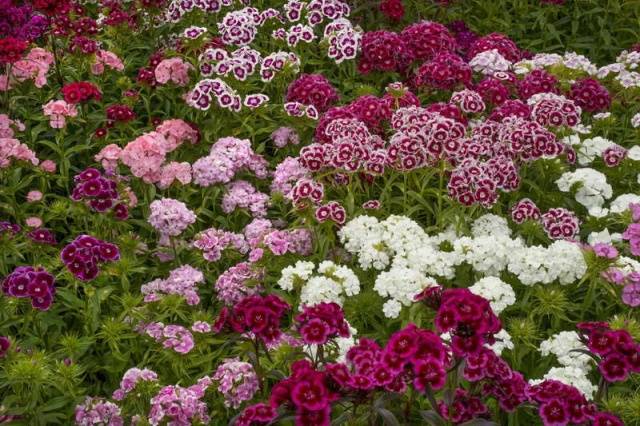

Flowers grow well in any region of Russia, tolerate frosts well and react relatively calmly to short-term heat.
Excess moisture is the main enemy of plants. In excessively moist soil, the root system of flowers is quickly affected by fungal diseases. As a result, the flowers may die. Therefore, for growing carnations, select areas where rain or melt water does not stagnate.
Pay attention to the groundwater as well. Their occurrence too close to the surface of the earth can negate all your efforts - the flowers will simply rot. When planning planting in such areas, you need to take care of drainage in advance, be sure to add sand to the soil and raise the flower beds by 30-40 cm.
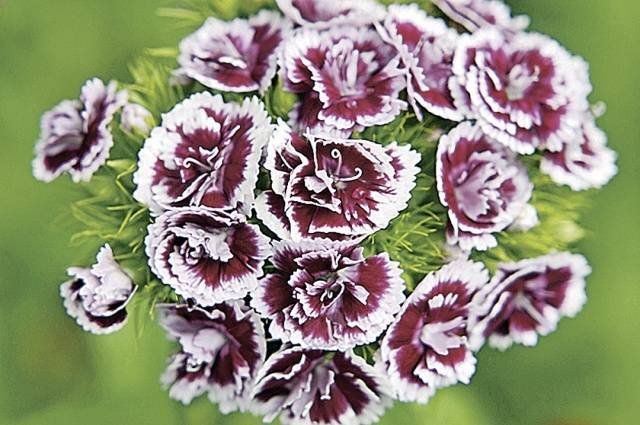

Which variety or hybrid to choose
Like all popular garden plants, the Turkish carnation is actively selected. There are two “basic” varieties, Dianthus barbatus L. and Dianthus barbatus var. asiaticus Nakai, which differ slightly in leaf width. Thanks to their ability to easily hybridize with each other and with other species, a variety of colors has appeared.
Varieties and hybrids with the same height and bush shape, similar leaves, but different colors are often combined in a series. Distinguish between undersized, up to 20 cm, and tall, up to 60 cm. The former are used in landscape design as ground cover or border plants.
Among the popular varieties are the following:
- Heimatland is an early long flowering cultivar. The bush is medium-sized, about 50 cm, the flowers are dark red, with a white eye.
- Lahskenigin - early flowering, with a compact, up to 45 cm, bush. Each shoot has several buds with pinkish salmon petals.
- Purple Mountain - is distinguished by a rare, rich purple color of petals.
- Schneeball. The flowers are snow-white, fine-toothed; round bush up to 40 cm.
- The Little Wiley series are compact, abundantly flowering carnations of red, white and pink shades with lighter edging.
- Dynasty F1 - a series characterized by branched shoots and double flowers. Hybrids bloom profusely in the first year; can be white, pink, burgundy and purple.
- Egyptian - maroon flowers with white edging.
- Black is a tall bush covered with maroon flowers to black; buds well in the first year.
- Macarena F1 - a series of terry carnations in white, burgundy, fuchsia and pink colors.
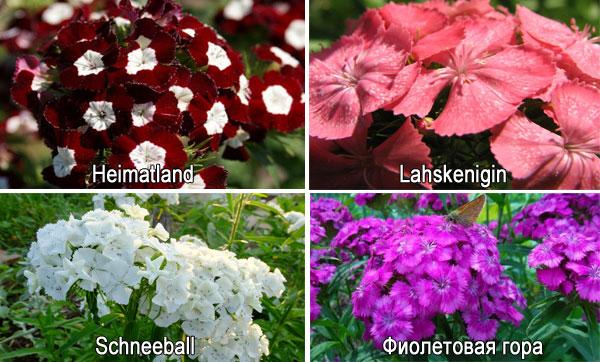

New varieties, plain and contrasting, simple and terry, appear every year.
Carnation varieties
In the garden, the flower is usually grown as a hybrid resulting from crossing the Carthusian and Chinese carnations. A rather characteristic feature of most varieties is their growth. The dwarf and tall varieties usually have larger, more showy flowers with an intense color. Often biennial carnations are multi-colored, there are varieties with decorative spots on flower petals and a typical spot in the center.
| Variety name | Turkish carnation photo |
| Albus |
With white flowers. A plant ideal for planting in classic rocky gardens, as a curb for garden paths.
A flower with a characteristic center and white edges. Available in several colors: salmon, raspberry, purple and pink.
Barbarini Pearl bicolor - has a white rim with red petals. The variety can reach a height of 40 cm.
Barbarini Purple Picoti, like Barbarini Purple Bicolour, has a characteristic white edge, but is distinguished by two-tone pink-purple petals.
Black Magic - a variety with maroon flowers (sometimes becoming almost black) looks original. On average, it reaches a height of 35-50 cm, it is recommended for perennial beds, creating flower arrangements in the garden, intended for cutting.
Green Trick stands out from other varieties with extremely decorative, catchy pompom flowers. This is a rather unusual, extravagant plant. When grown correctly, it can bloom 2 times a year. Due to its uniqueness and durability, the variety is ideal for garden arrangements, bouquets of flowers.
The group has dark flowers - rusty red or brown. The original inflorescences make them extremely decorative plants. Ideal for a flower bed, like a cut flower. This group of varieties is quite vigorous, reaching a height of 60 cm.
Hart Attack is a medium-sized variety with dark red flowers
Scarlet Beauty has beautiful red flowers, collected in umbellate inflorescences. It grows up to half a meter in height. Ideal for home beds, garden paths as a curb, cut flower.
Var. Albus and var. Rubrum - the varieties that are of the greatest importance of all varieties in horticulture, characterized by large flowers and an early flowering date.
Dark purple variety.
Variety with scarlet flowers.
Carnation variety 50 cm high, Flowers - bright purple
Variety 50 cm high, used for flower beds, flower beds, cut flowers. The color of the petals is scarlet.
Dwarf carnation variety with flattened purple flowers.
A low bush with pale pink inflorescences.
Annual variety of Turkish carnation - a mixture of colors. Blooms in June, blooms until September.
Herbaceous carnation with small double inflorescences, bush height 50 cm. Suitable for growing in Moscow, Moscow region.
Dense, flattened inflorescences on a bush up to half a meter high.
Dwarf variety with multi-colored inflorescences up to 25 cm high.
Noteworthy varieties: "Holland", "Desh", "Moskvichka", "Barbarini", "Montpensier", "Terry dynasty".
Timing and lunar calendar for sowing Turkish carnations
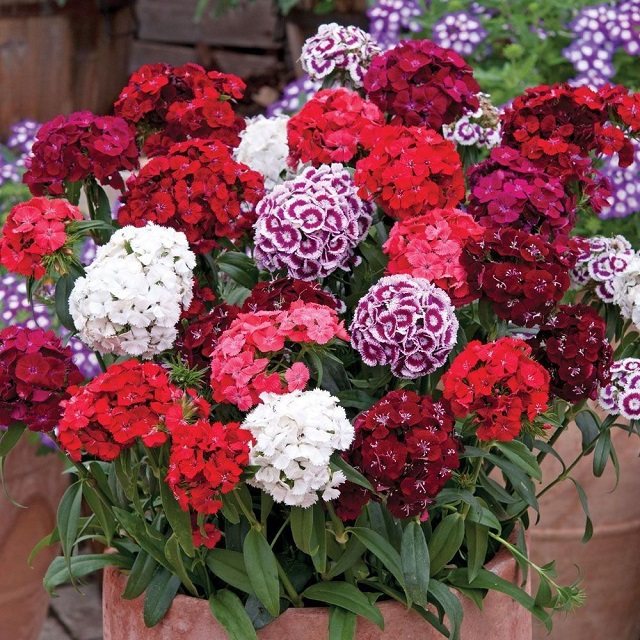

Turkish carnations can be grown in seedlings or sown directly in open ground in summer or autumn before winter:
- For growing seedlings, sowing is done in March and early April. You can sow earlier, but then the seedlings will need to be illuminated.
- In summer, seeds are sown on a daughter bed, and closer to autumn, bushes are planted in a flower bed.
- Towards winter, Turkish carnations are sown in late autumn, when the ground is already freezing and even in the snow. Learn how and when to plant flowers before winter with an example marigolds.
Since planting can be done almost all year round, we offer you favorable days according to the lunar calendar 2020, when you can plant Turkish carnations:
- January 1, 5, 6, 8, 9, 28 and 29;
- February 2, 3, 6, 7, 24 and 25;
- March 2, 3, 27, 28, 30 and 31;
- April 1, 2, 6, 7, 24, 28 and 29;
- May 3-6, 25, 26 and 30;
- June 1-4, 22, 28-30;
- August 1, 24-28;
- August 1, 20-25, 28 and 29;
- September 18-21, 29 and 30;
- October 18, 21-23, 27;
- November 23, 28, 29;
- December 16, 20, 21.25 and 26.
Getting ready for landing
When growing Turkish carnations from seeds, it is important to properly prepare the soil before planting. Unlike other garden flowers, it is completely undemanding to the composition of the soil.
Comment! From Latin "carnation" is translated as "flower of the Gods".
However, for lush flowering and the preservation of varietal characteristics, it is necessary to take into account that the carnation loves sandy loam, sandy, or fertile soils, with neutral acidity. If possible, add Turkish compost, humus or wood ash to the soil before planting clove seeds.
Most flower growers prefer to grow carnations the old fashioned way, using seedlings. You can sow seeds both in the soil mixture purchased at the store, and in the garden soil, diluting it with sand in a ratio of 2: 1.
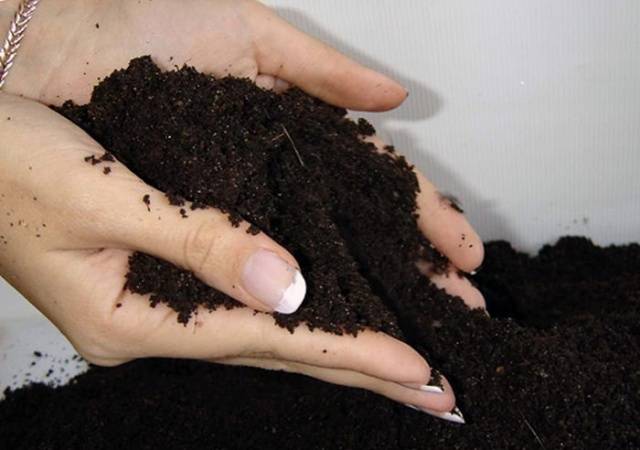

Any containers for growing Turkish carnations from seeds at home are suitable. Sowing can be carried out both in separate cups and in bulk containers. Prepare a sunny, warm place for flowers right away. The optimum temperature for seed germination is + 20˚С.
Before planting, clove seeds can be soaked in water with the addition of a growth stimulant. However, they germinate very quickly - 7-10 days after sowing. Therefore, in principle, they do not need additional treatments.
Seedling method
When growing a Turkish carnation from seeds, as a rule, there are no particular difficulties. You can start sowing flowers in late February - early March. In warm regions, sowing work begins no earlier than the end of March - beginning of April.
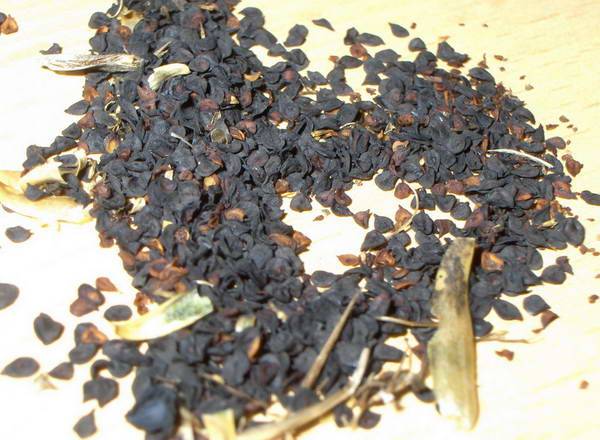

When determining the sowing time, keep in mind that transplanting flowers into open ground must be done before the onset of extreme heat.
A feature of growing Turkish carnations for seedlings is the fact that the plant does not like transplanting. Therefore, it is advisable to sow flowers in peat glasses or tablets in order to exclude the process of subsequent picking and to facilitate transplanting into open ground.
Attention! In the UK, this beautiful flower has the intriguing name "Sweet William" for the sweet taste of the inflorescences.
When sowing Turkish carnations for seedlings, you must perform the following steps:
- Lay a drainage layer on the bottom of the container with drainage holes, as usual, and fill it with prepared soil to 2/3 of its volume.
- Spread the carnation seeds on the surface, the minimum distance between which is 1.5 to 2 cm.
- Sprinkle the flower seeds lightly with soil or sand, a layer of 0.5-1 cm will be enough.
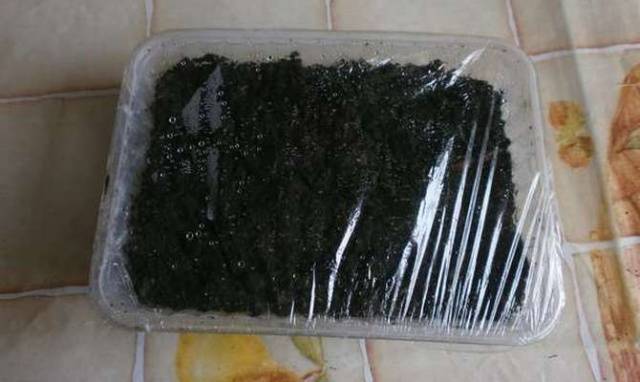

- Cover the container or containers with plastic wrap and place in a warm place. It is advisable that direct sunlight does not fall on the landings.
- Water the seedlings as needed, but no more than 2-3 times a week. It is advisable to provide the flowers with gentle watering - moisten the soil with a spray bottle.
- Subject to the rules of planting Turkish carnations for seedlings, the first, bright green loops appear after 7-10 days. After germination, the film must be removed from the container and the seedlings must be transferred to a lighter place.
- Water the flowers regularly. But keep in mind that carnations don't like overly moist soil.
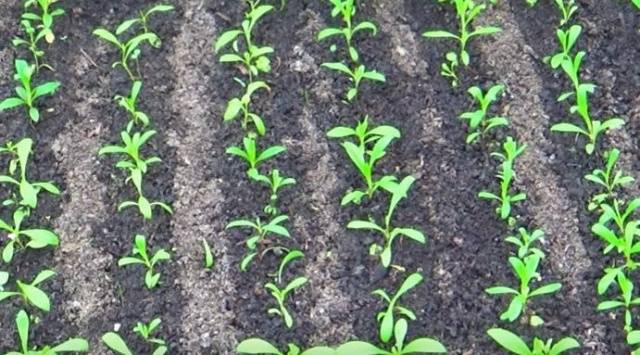

- After 2-3 weeks, you can start picking seedlings. If you sowed flowers in separate containers, this stage of growing seedlings of Turkish carnations can be excluded. It is necessary to dive seedlings exclusively by transshipment, keeping a distance of 8-10 cm between them.
- In open ground, flower seedlings are transplanted in late May - early June. Before replanting a carnation, be sure to harden the plants. When transplanting, you must follow the recommended planting scheme.
- Immediately after transplanting, the flowers must be covered with foil or lutrasil until the rooting process takes place. Once it is clear that the plants have taken root, the shelter can be removed.
As you can see, there is nothing difficult in growing seedlings of Turkish carnations. It is only important to follow the recommendations, and soon your flower beds will be covered with a bright, floral, fragrant carpet.
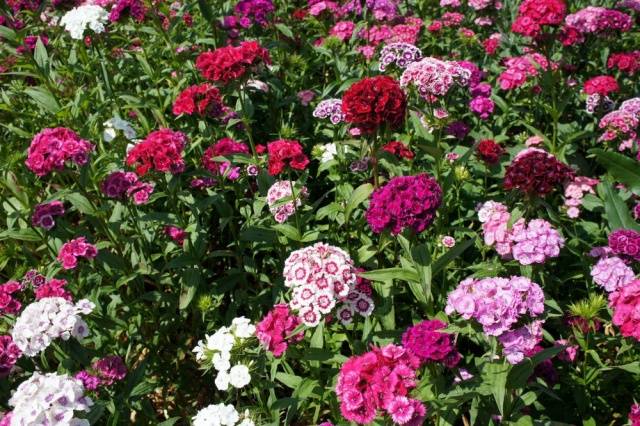

Comment! In the 18th century in France and in the last century in Russia, the carnation became a symbol of the revolution.
Sowing seeds in open ground
In spring, you can plant Turkish carnations with seeds as soon as a stable temperature of + 15˚C + 18˚C is established outside. The optimal planting dates in central Russia are in mid to late April. In regions with a more severe climate, cloves can be sown no earlier than early to mid-May.
A few days before planting, the flower garden must be carefully dug up and moistened. It is not necessary to soak and process the seed material before planting. Flowers easily tolerate short-term frosts. But wet carnation seeds can die when the temperature drops.
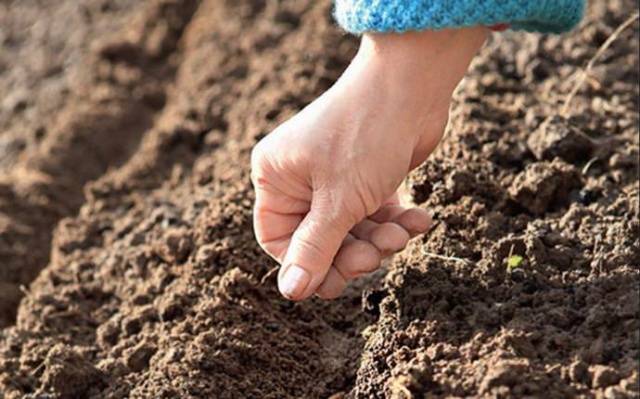

Make neat, even grooves 1-1.5 cm deep. The distance between the rows should be at least 15-20 cm. Pour warm water over the grooves. Spread the flower seeds in 1.5-3 cm increments. Lightly sprinkle the plantings with soil.
Before the seedlings emerge, the beds must be covered with foil. As soon as the seedlings of Turkish carnations grow up, the seedlings need to be thinned out. Excess seedlings are either removed or carefully transplanted to another location.
The ideal distance between plants is 15-25 cm, depending on the variety and height of the flowers. For carnations, it is important that the plantings are not thickened, otherwise the flowers will often suffer from fungal diseases.
Advice! Before growing Turkish carnations from seeds in the open field, take care of suitable neighbors - do not sow it next to moisture-loving flowers.
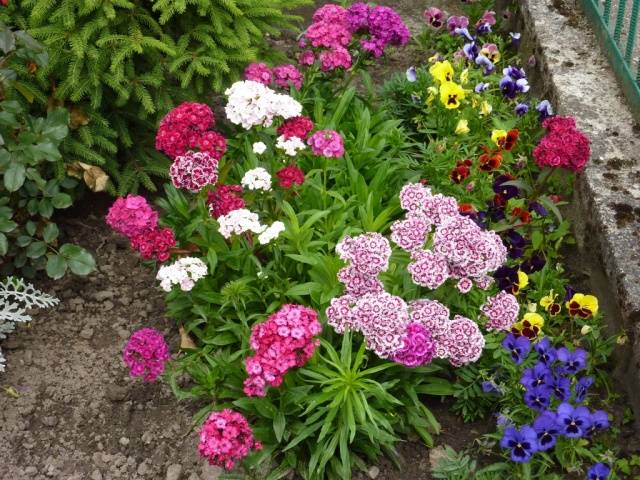

Before winter, carnation seeds are sown no earlier than the first autumn frosts hit. Early to mid-October is the most favorable period for planting operations. Sowing technology practically does not differ from planting carnations in spring. There is only one difference. Neither soil nor seed material can be watered or soaked. Dry seeds of Turkish carnation are sown in dry grooves, lightly sprinkled with soil and mulch planting.
If you wish, you can cover the future flower garden with spruce branches, hay or straw. In the spring, as soon as the snow melts, the covering material is removed. As in the first case, do not forget to thin out the planting.
How and when to dive Turkish carnation seedlings
The most suitable timing for picking seedlings of Turkish carnations falls on the stage of development, when 2-3 true leaves grow in plants. You can transplant into the same ground, and it is advisable to use individual containers. If you still want to plant in a common box, then the distance between plants in such a container should be at least 7 centimeters.
It is necessary to dive seedlings of Turkish carnations according to the following rules:
- Water the plants ahead of time so that the water can be absorbed.
- Fill new containers with soil, make depressions.
- Gently pick up the seedlings, transfer them to the hole along with the earthen clod, deepen the cotyledon leaves.
- Cover the hole with soil, compact the soil slightly and water.
Advice! It is recommended to carry out the procedure on a cloudy day or in the evening when the sun is inactive.
Leaving after a pick does not change significantly, however, there are some rules:
- It is recommended to shade the plants for the first few days after the procedure so that direct sunlight does not come into contact with the seedlings. The fact is that at this moment they are very vulnerable, they adapt.
- After picking, when the plants have 5 full-fledged true leaves, you can pinch the top shoot of Turkish carnation seedlings to form a beautiful bush.
- After about 14 days, you can feed the seedlings. For this, use mineral complex fertilizers for seedlings, for example, Agricola, Fertika Lux, Nitroammofosk (the concentration is two times lower than that indicated on the package).
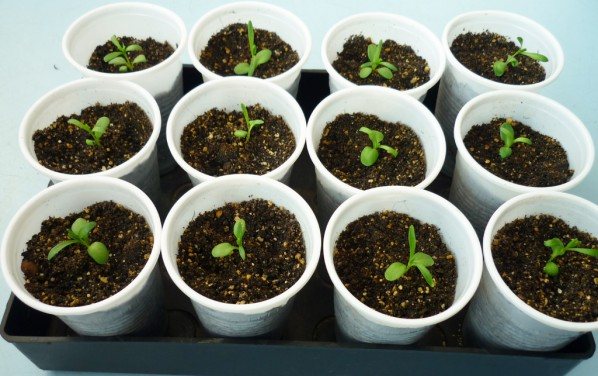

The Turkish carnation is a refined and graceful flower that can win the heart of any grower and summer resident. The agrotechnology of growing seedlings is not difficult, even a beginner can grow strong, strong and good plants. However, do not forget that you can achieve good results only with the correct execution of each stage and following the scheme.
Reproduction of carnation
There are three ways to propagate a Turkish carnation:
- seeds;
- cuttings;
- layering.
Seed propagation is described above.
Propagation by cuttings
Cuttings are cut from biennial plants at the beginning of summer, which are planted in a temporary bed. They are placed in moist soil at a 45-degree slope and covered with a transparent cap (glass jar or cut-off plastic bottle). Cuttings take root for about three weeks, during which you need to monitor soil moisture and air the plantings every day.
Reproduction by layering
Turkish carnation propagates well by layering. To do this, use the grown stems of biennial plants. A small groove is made near the bush, into which the stem is laid and pinned. The layering is sprinkled with soil and gently watered. After about a month and a half, roots will appear on the layer, and it can be separated from the mother plant.
The Turkish carnation also reproduces well by self-sowing. If, after flowering, the faded buds are not cut off, then new plants will grow on the flowerbed every year.
Reproduction by layering
The variety you like can be propagated by layering:
- To do this, take a stem, press it to the ground, pinning it with a V-shaped wire at the crown.
- The peduncle should be removed.
- Sprinkle the stem with wet soil.
- After a month, rooting will occur, the layers can be transplanted to a permanent place.
- Such reproduction completely copies the mother variety.
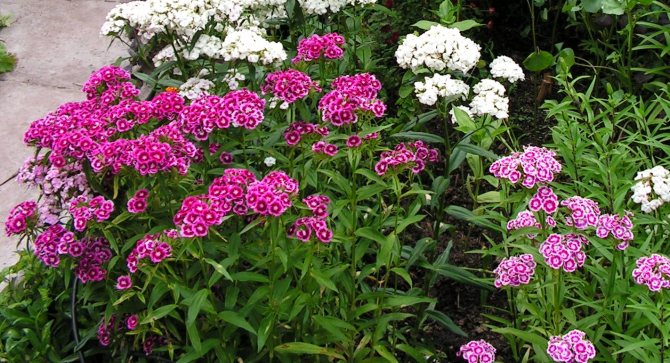

Site selection and soil preparation
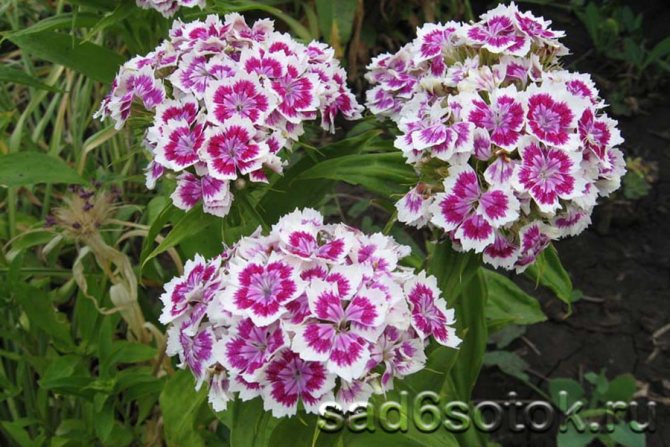

Growing Turkish carnations
Turkish carnations are mainly grown in a biennial culture, winter in the ground and emerge early, forming flowers by early June, and some varieties even earlier - already in mid-May (Haimatland).
For early growing season, well-heated areas on a hill are allocated under a flower bed of carnations, ensuring the timely descent of melt water. Tall varieties can be damaged by gusty winds, so it is advisable to plant plants in places protected from the prevailing winds.
Plants are undemanding to soils, but they develop better on fertile loamy or sandy loamy soils. For spring digging, 8-10 kg of well-rotted humus are introduced; the use of fresh manure is unacceptable.
Acidic soils are limed, scattering from 5 to 10 kg of freshly slaked lime per 10 square meters.m, depending on the acidity and density of the structure - heavy soils require more lime than light ones. The structure of heavy soils is lightened by the addition of sand or high peat.
Carnations bloom better when placed in the open sun, but many varieties thrive in thin partial shade, extending the flowering period. An excellent shade and background for colorful Turkish carnations will serve as screens of clematis blooming in the same period.
Plant characteristic
The Turkish carnation (Dianthus barbatus) is one of the most popular flowers in gardens. It grows wild in Asia (China, North Korea). In Europe, an ornamental plant appeared in the 16th century.
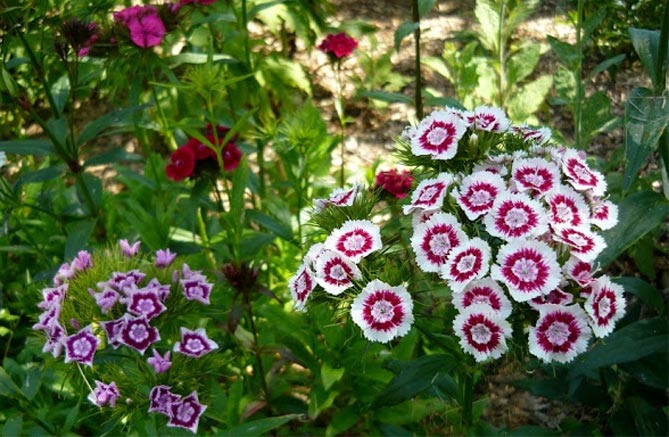

Interesting! In England, the flower is called "Sweet William" (Sweet William).
The perennial Turkish garden carnation belongs to the carnation family; it is found in summer cottages, where it often stays in flower beds. This short-lived perennial is usually grown as a biennial plant because it blooms most profusely in its second year.
In the year of sowing, the plant forms bushes with dark green leaves, and in the spring of the next year it forms long stems on which inflorescences appear.
The plant reaches a size of 30-40 cm, sometimes even higher. But more often they choose dwarf varieties, the height of which reaches 30 cm. Dwarf carnations are not as vulnerable as tall ones, especially on rainy and windy days.
It's worth knowing! Delicately fragrant inflorescences of Turkish carnations are edible - they use petals. You need to remove the base of the petal to get rid of the bitter aftertaste. Delicate petals, candied petals can be added to creams, syrups, salads, fruit cakes. Candied carnation petals accentuate the character of the sweet baked goods.
The best time to grow carnations is during the flowering period (from June to the end of August of the second growing year). A characteristic feature of the plant is the large inflorescences, collected at the top of the stem, adorning the garden with numerous white, pink and red flowers. One inflorescence can consist of 30-40 flowers. Flower baskets with 5 petals, scalloped, fragrant.
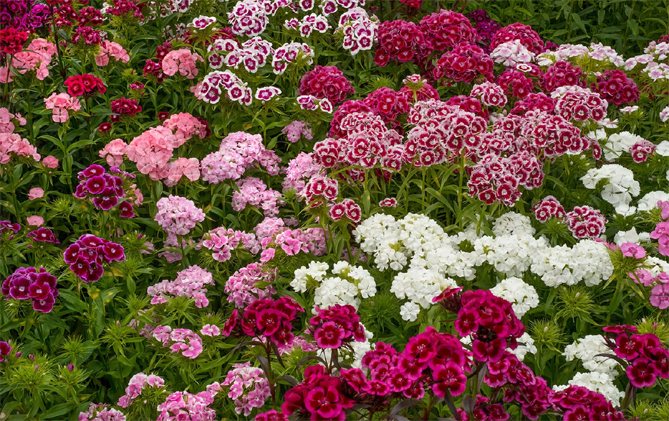

There are varieties of multicolored and contrasting colors in the middle of the flower. The plant has wide leaves, rather lush shape, solid stems. The clove is easily recognizable due to its characteristic strong spicy scent.
Preparing for winter
This plant is hardy. But, despite the resistance of the carnation to the cold, it should still be covered for the winter. You can cover the bushes with spruce branches, cover them with a peat mixture. In the spring, when the snow melts, the bushes should not be opened immediately, since in spring there is a great threat of severe frosts. When the plant grows in spring, the covering material is removed, and the young shoots are shaded. This plant does not tolerate excess moisture very well, so in winter, if too much snow falls, it is better to remove it. So in the spring there will be no excessively wet soil in a flower bed with Turkish carnations.


